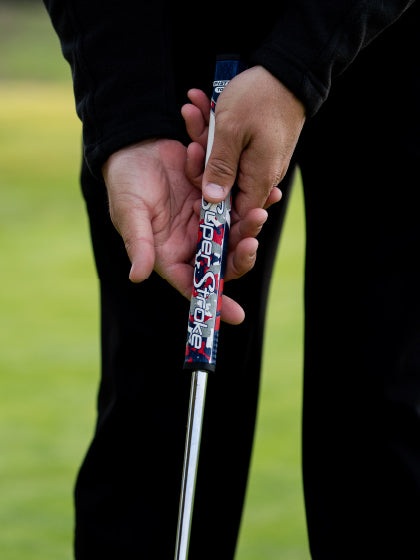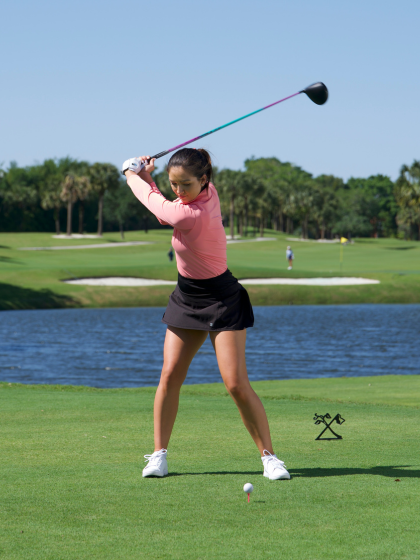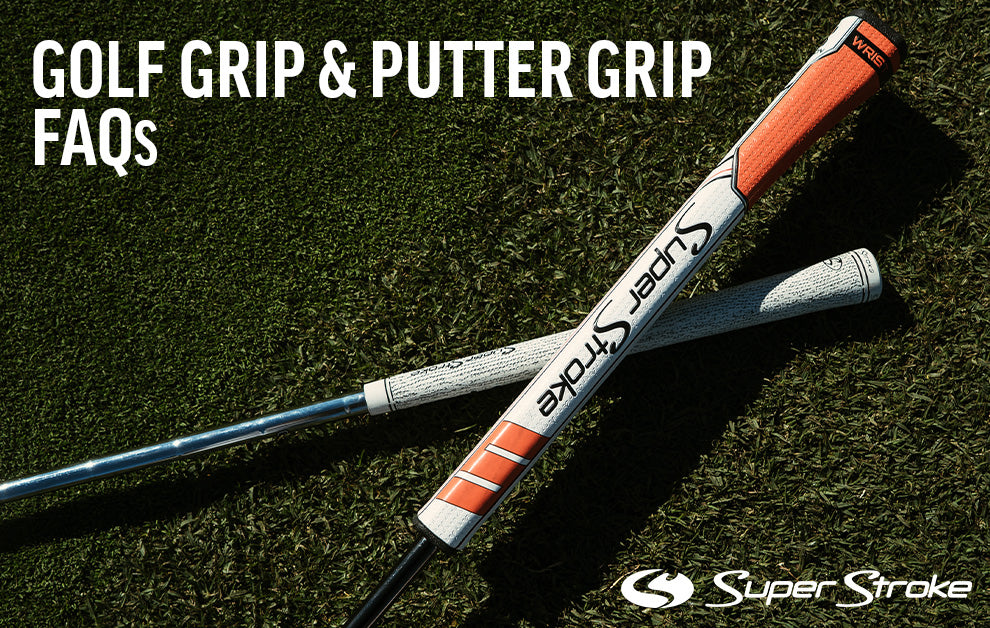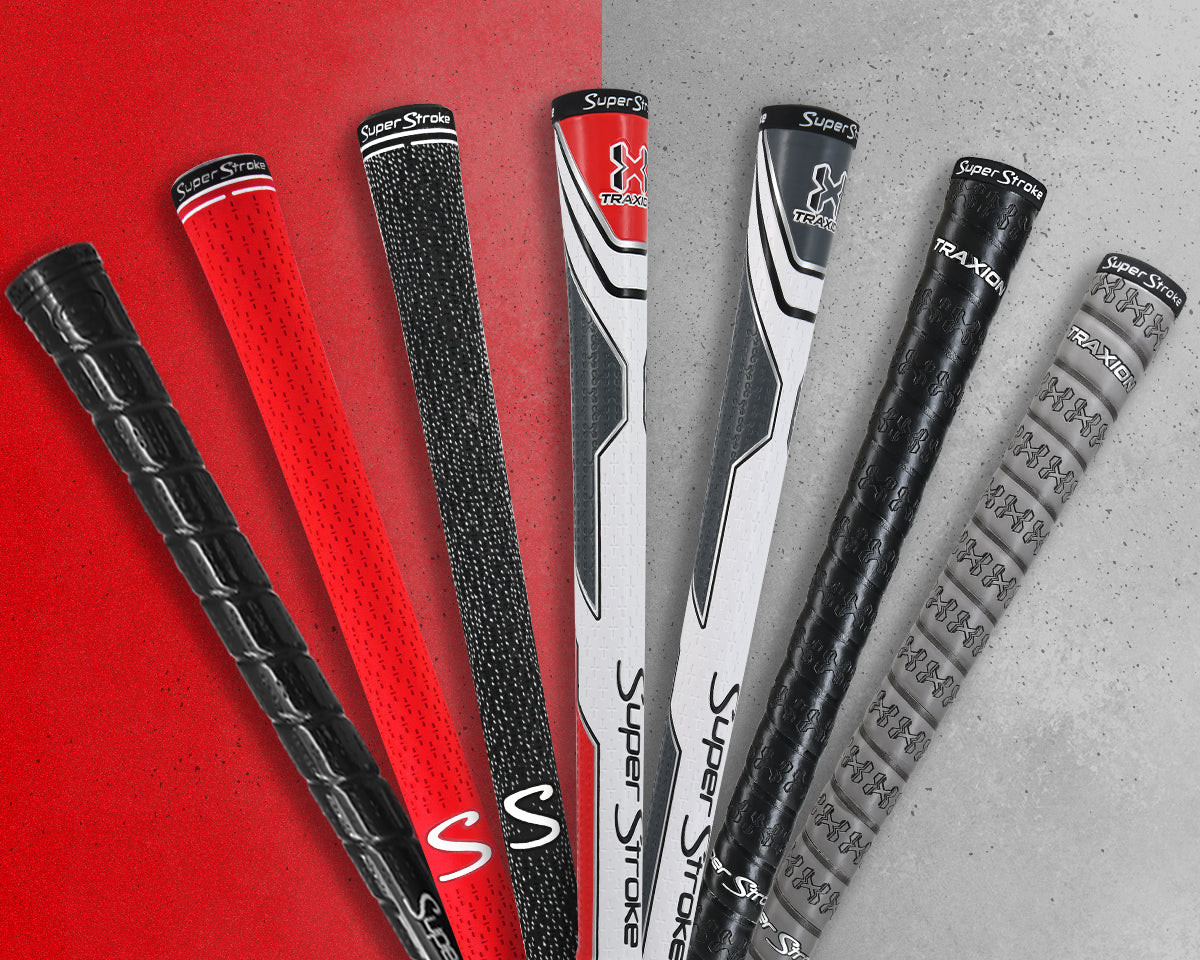The golf grip may be the most overlooked part of a golf club, but this simple component can have a big impact on your swing, your putting stroke and your results.
A golf grip’s size, shape and surface texture all affect performance. So can the grip’s condition; a dirty or worn-down grip is sure to wreak havoc on your game.
Remember, it’s always best to consult a PGA teaching professional for advice on your swing or putting stroke, and which equipment changes may help you improve.
SuperStroke is proud to make some of the best golf grips available. In this FAQ, we’re hoping to answer some of your most pressing questions including the most popular putter grip on the PGA Tour, the variety of SuperStroke putter grip sizes, the most popular SuperStroke putter grip and so much more.
Should I use the same grip on all my golf clubs?

Yes, using the same golf grip for your clubs – from driver through wedges – provides consistent feel and feedback. It’s also critical to your consistency. The only exception is the putter grip, of course.
Let’s say your wedge grips are thinner than the grips on your mid-irons. As we’ll explain shortly, thinner grips encourage more hand and wrist action, while thicker grips limit these so-called “small muscles.”
With grips of different thickness, your pitching wedge swing could be significantly different from your 7-iron swing. This might cause disparities in your trajectory, direction and distance control.
Using the same SuperStroke club grips across all your golf clubs takes that variable out of the equation and the best golf grips will deliver a consistent feel.
What is the difference between standard, midsize and oversized putting grips?
There’s a small but significant difference in thickness (diameter) between the three sizes of SuperStroke putter grip sizes. For example, the midsize model of SuperStroke’s Traxion Tour Grip is 1/64” larger than the standard size, while the oversized is 1/32” larger than standard. We also offer under-sized grips that are 1/64” smaller than standard.
Larger grips also weigh slightly more than standard and under-sized grips.
Can changing grip size improve my shot shape?
Yes, changing golf grip size can certainly improve your shot shape.
In general, the thicker the grip, the more it will limit the movement of your hands and wrists. Thinner grips promote more hand and wrist action.
Let’s say you tend to push or slice the ball due to a poor release through impact. A thinner grip could free up your hands to roll over more easily.
Or perhaps you have overactive hands and a wicked hook. A slightly thicker grip may just straighten you out. SuperStroke grip sizes account for all of these things and more.
How often should I replace my club grips?
Regripping every year – or once every 30 – 40 rounds – is enough for most golfers. Obviously, the more you play and practice, the more often you should get new golf grips.
You should also clean your grips every few rounds, if not after every round. This will not only extend their life, but it will also remove oil, sweat and dirt that diminish the grip’s tackiness. Simply use dish soap, warm water and a washcloth to scrub the grips, then rinse them dry with a soft towel.
Tip: Make absolutely sure you get all the soap off before drying.
After washing, you’ll immediately notice an improvement in the grip’s feel.
Should my putting grip also be changed? If so, how often?
Absolutely. The putter is the most-used golf club in the bag, and arguably the one with which feel is most important. Follow the same guidelines for your putter grip as you do with regular grips, changing it every 30 – 40 rounds and cleaning it frequently.
How do I change my putter grips and club grips?
It’s easier than you might think to regrip your golf clubs yourself.
First, you’ll need a few things to get started on installation, including a table or workbench, a vise, a molded rubber clamp (so you don’t damage the shaft), a box cutter and some two-sided grip tape.
Secure the putter’s shaft in the vise and use the box cutter to carefully slice through the old grip, from bottom to top. Pull off the grip.
Next, peel off the old tape and use a solvent and cloth to remove any residue. You’re ready to install new SuperStroke putter grips.
Measure a piece of two-sided tape to match the grip’s length plus one inch. Place the tape along the shaft, with the excess above the shaft’s end. Twist and push the extra tape down into the shaft.
Spray solvent onto the tape and into the new grip; pour it out after coating the inside of the grip. Push the grip onto the shaft and turn it so the front is aligned at a 90° angle to the clubface.
Let the new SuperStroke grip dry for one hour and you’re ready to roll.
Who are oversized putter grips designed for?
Actually, oversized putter grips are designed for everyone. The ideal putting stroke is controlled by the arms and shoulders, with as little hand and wrist action as possible. Because of your hands’ anatomy, oversized grips naturally limit their movement and promote a proper, “pendulum-style” stroke.
Oversized putter grips also relieve stroke-killing tension in the hands, wrists and forearms, so you won’t squeeze the club too tightly – even when the match is on the line.
Consulting a SuperStroke putter grip size chart and selector guide will give you an idea of the range of options we offer.
Are some putter grips designed specifically for different gripping styles?
Yes, SuperStroke has created specialty grips for golfers who use the “claw” and “wrist-lock” styles. These putter grip options are among the best for these grip styles.
Our Traxion Claw Putter Grip combines a pistol-style top portion, which helps lock in the lead or upper hand, and a bottom section sporting three flat sides for lower hand placement.
The SuperStroke WristLock Grip is uniquely designed to “lock” against the upper hand’s wrist, which all but eliminates excess motion. It works for traditional putting grips and strokes as well.
How does an oversized club grip alter or improve your swing?
Most golfers overuse the hands and wrists, especially when hitting iron shots and chipping. “Flipping” or “scooping” at impact – trying to lift the ball into the air by breaking the wrists – is one of the most common problems in golf.
Some oversized club grips can help solve this issue by “quieting” your hands and putting your “big muscles” (arms, shoulders, hips and torso) in charge of the swing.
Larger grips may also benefit golfers who tend to grip the club too firmly, which causes tension and limits their rotation.
What are “cord” grips, and what advantages do they have over regular grips?

“Cord” grips, like our S-Tech Club Cord model, are regular rubber grips with fabric strands embedded along the surface. The fabric wicks away sweat, water and other moisture to maintain surface tackiness.
Players with sweaty hands, or those who often face damp or humid conditions, prefer cord grips for their moisture-fighting features.
We also make wrap-style grips, known for their soft texture, superior feedback and excellent durability, as well the Cross Comfort Grip – a non-slip model that’s exceptionally supple.
Why do putter grips have a flat front, instead of being completely round like grips for other clubs?
The answer is simple – the putting stroke isn’t like the regular golf swing, so the putter grip has a flat front for more stability on the greens.
In the full swing, you need the hands and wrists to rotate and hinge freely on the backswing, through impact and into the follow-through, so a round grip works best.
When putting, it’s important for the hands and wrists to stay still. A flat-fronted grip helps prevent twitching and keeps the hands square to the stroke path. It also matches your hand position to the putter’s face, which aids in squaring the blade at impact.
What is counter-weighting on a putting grip, and how can it help my putting?
Counter-weighting, or counter-balancing, is simply adding weight to the putter’s grip end. This makes the clubhead feel lighter, so it’s often done with heavier putters.
Counter-weighting limits the putter face’s rotation through the stroke, making it easier to strike the ball squarely. It can also smooth out your tempo and improve consistency.
It often takes some trial and error to get just the right amount of weight in the handle. The best putting grip for SuperStroke counterweighting is either the CounterCore Flatso and CounterCore Pistol GT grips, which both offer adjustable weighting, allowing you to experiment until your putter is perfect.
What putter grip do the pros use?

SuperStroke is the most popular putter grip on the PGA Tour. Like recreational golfers, pros vary in their choices, but it’s clear that most trust SuperStroke.
Of our most popular models, SuperStroke’s pistol-style grips tend to be the most used on tour.
Major champions Jordan Spieth and Patrick Cantlay, who represent SuperStroke on the PGA Tour, both use the Traxion Flatso. Another SuperStroke Ambassador, , uses the Traxion Pistol GT 1.0. Sungjae Im uses the 1.0 PT putting grip.
Since our founding in 2009, professionals using SuperStroke grips have won hundreds of tournaments and more than $500 million worldwide. SuperStroke putter grips are routinely played by more pros than any other brand.
What is the most popular SuperStroke putter grip?
With so many different grips for various grip styles, it can be difficult to pinpoint exactly which is the most popular SuperStroke putter grip. However, along with PGA Tour pros, many people like the Traxion Pistol GT and Traxion Flatso styles. Specialty grips for specific grip styles are also excellent choices if you favor a particular style.
Who knew there was so much to learn about golf grips! SuperStroke is proud to offer the most popular putter grips on the PGA Tour as well as other golf club grips that can bring more consistency and feel to your game.






4 comments
Customer Support
Hi Simon, yes, we make a Claw putter grip that comes in two sizes, 1.0 and 2.0. For more information contact us at CS@SuperStrokeUSA.com.
Hi Simon, yes, we make a Claw putter grip that comes in two sizes, 1.0 and 2.0. For more information contact us at CS@SuperStrokeUSA.com.
Simon Griffiths
Hi, I use a claw grip. Any guidance on the most suitable Super Stroke putter grip?
Hi, I use a claw grip. Any guidance on the most suitable Super Stroke putter grip?
Customer Support
Hi John! All of our putter grips have a core size .58", so if your putter shaft is larger than standard, you may need to use a LOT of grip solvent to get the grip on. Feel free to reach out to our Customer Service email for additional help at CS@SuperStrokeUSA.com.
Hi John! All of our putter grips have a core size .58", so if your putter shaft is larger than standard, you may need to use a LOT of grip solvent to get the grip on. Feel free to reach out to our Customer Service email for additional help at CS@SuperStrokeUSA.com.
John M Duncan